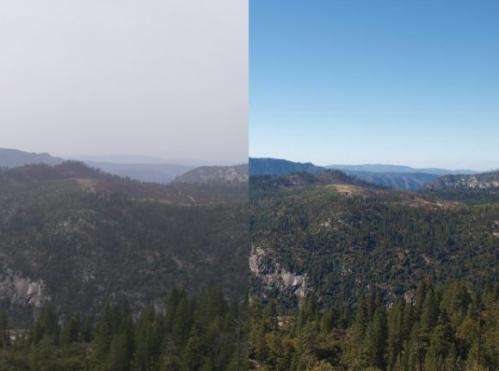Unexpectedly large sunlight reflecting impact of big particles in a clean sky

(Phys.org)—A few large particles in a crowd of tiny ones have often been ignored when calculating the amount of sunlight bounced back into space in clean-sky conditions. Scientists at Pacific Northwest National Laboratory found that these "giant" particles have a larger-than-expected impact on the amount of sunlight reflected away from Earth, by as much as 45 percent. They also showed that particles larger than one micron (0.000039 inch) occur much more frequently than expected, up to 85 percent of the time.
"Many routine measurements are unable to sample large particles, thus they may overlook the residence of many 'Gullivers in the country of Lilliput,' said Dr. Evgueni Kassianov, PNNL scientist and lead author of the study. "Our results show these 'invisible giants' play a much greater role in reflecting solar energy back into space than previously thought."
Tiny atmospheric particles called aerosols get in the way of sunlight beaming down to Earth. They either absorb or scatter sunlight. The human eye catches these effects when particles get in the way of viewing distant mountain tops. Scientists can measure particle presence using ground-based and airborne instruments. Because there are so many small particles and so few large ones, measurements have concentrated on capturing the characteristics of the small ones. This new study shows that in clean air, just a few, larger particles have a much greater influence on reflected sunlight than previously thought. Revealing the true nature of these "giants" suspended in the atmosphere will improve models that predict how the climate will react in all conditions.
Many routine measurements have failed to capture the amount of large aerosols, particles greater than one micron, in the atmosphere in clean sky conditions. Without a complete picture of the effect of aerosols on the atmospheric radiation budget, these routine measurements did not provide the important observational constraints needed to assess and improve climate models.
The PNNL researchers performed a two-step study using daily observations from an integrated dataset collected during the Carbonaceous Aerosol Radiative Effects Study (CARES) field campaign held in 2010 near Sacramento, California. The data analysis revealed surprisingly large and frequent contributions (up to 85 percent of the time) of large particles to the total volume of aerosol particles. Co-incident ground-based and aircraft data collected at and above two sites verified the existence of large particles.
In the second step, the team used state-of-the-art radiative transfer calculations on the CARES dataset to show the large aerosol particles' effect on the amount of sunlight reflected back into space. They found the large particles had an unexpectedly significant influence on the amount of reflected sunlight.
Researchers plan to perform similar two-step studies on datasets collected around the world, including data from the 2012 Intensive Observation Period of the Two-Column Aerosol Project (TCAP) near Cape Cod, Mass. These studies will provide additional improved observational constraints for regional and global climate models.
More information: Kassianov E, M Pekour, and J Barnard. 2012. "Aerosols in Central California: Unexpectedly Large Contribution of Coarse Mode to Aerosol Radiative Forcing." Geophysical Research Letters 39:L20806. DOI: 10.1029/2012GL05346.
Journal information: Geophysical Research Letters
Provided by Pacific Northwest National Laboratory


















